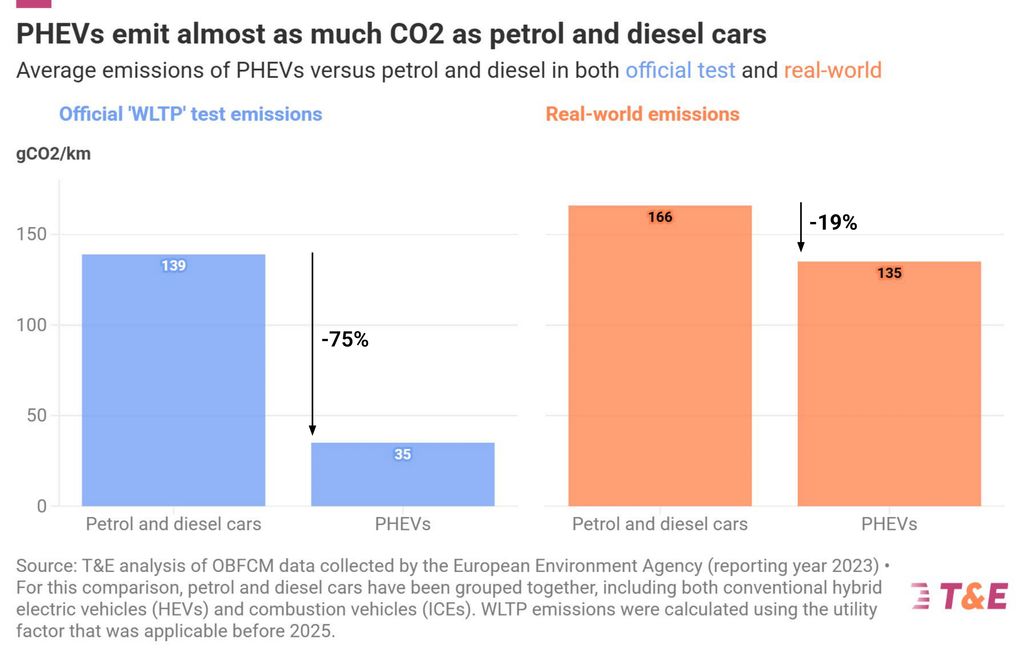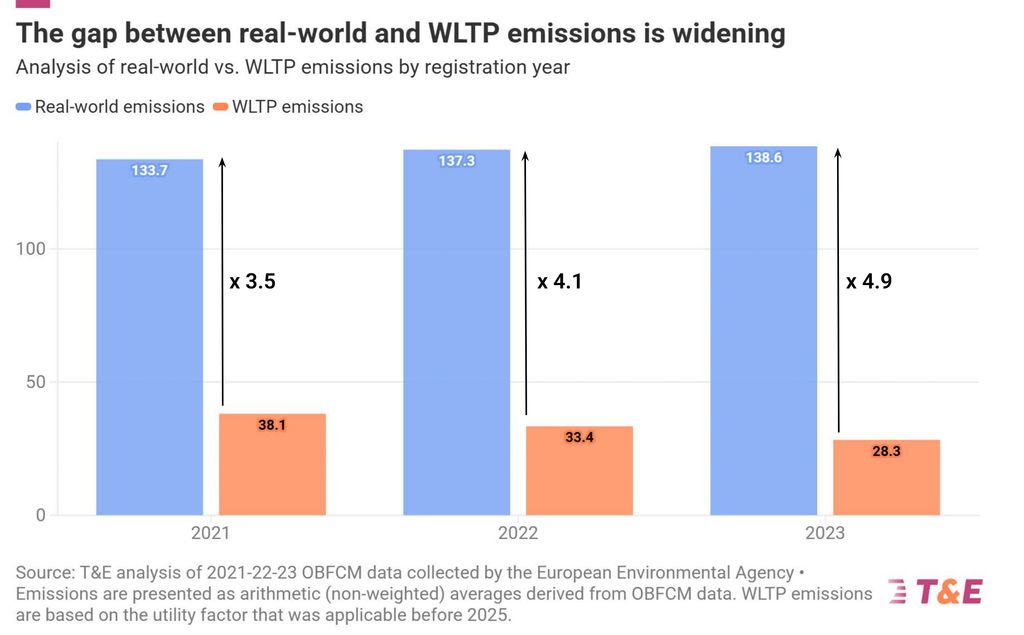- Volkswagen, Mercedes-Benz and BMW saved billions of dollars in emissions penalties due to WLTP’s flaws, according to a new study.
- WLTP’s overly optimistic emissions estimates allowed automakers to sell more plug-in hybrids and fewer EVs.
- That resulted in 52 million tonnes of additional CO2 emissions between 2021 and 2023, while also costing drivers more to refuel their PHEVs.
A scathing new study has found that some of the world’s largest automakers avoided billions of dollars in European Union emissions penalties due to the shortcomings of the WLTP testing procedures.
Flaws in the WLTP testing system—short for Worldwide Harmonised Light Vehicles Test Procedure—allowed automakers to sell more than a million fewer EVs in Europe between 2021 and 2023 than they otherwise would have had to produce.
Instead, automakers boosted sales of plug-in hybrids (PHEVs) that drivers rarely charged, resulting in millions of additional tonnes of planet-warming greenhouse gas emissions that could have been avoided otherwise.
The flaws didn’t just inflate emissions; they also hit drivers’ wallets, adding up to $1,100 a year in extra fuel costs as many PHEV owners relied on gasoline or diesel instead of charging up. Photo by: Transport & Environment (T&E)
Europe’s clean transportation advocacy group, Transport & Environment, published the study on Thursday, highlighting how the official emissions estimates for several PHEVs from Mercedes-Benz, Volkswagen and BMW under WLTP were significantly lower than their real-world emissions.
T&E said WLTP’s fleet CO2 emissions allowed automakers to comply with targets far more easily. This resulted in 52 million tonnes more CO2 emissions between 2021 and 2023. At the same time, automakers collectively saved nearly €6 billion ($6.5B) in fines by selling fewer EVs and more PHEVs. Volkswagen, Mercedes-Benz and BMW reportedly accounted for the largest share of these savings.
PHEVs are equipped with both an internal combustion engine and an electric powertrain. They can typically cover between 30 and 50 miles using battery power only. The combustion engine kicks in once that charge is depleted. The idea is to lower gas costs and emissions by relying on battery power for daily driving and the combustion engine for longer trips.
But owners can only benefit if they regularly charge their PHEVs. If not, they’re just lugging a heavy battery around which worsens both fuel economy and emissions. The International Council on Clean Transportation concluded in a previous study that PHEV owners in Europe rarely plug them in, relying mostly on the combustion engine, leading to emissions that are equal to or greater than those of regular gasoline and diesel cars. Photo by: Transport & Environment (T&E)
An InsideEVs investigation last year found that automakers had little data on their PHEV customers’ charging habits. Toyota had the data, but refused to share it with us.
The T&E study states that PHEVs emit as much CO2 as petrol and diesel vehicles. Official WLTP estimates suggest that model year 2023 PHEVs were 75% more efficient than gas and diesel cars, releasing 35 grams of CO2 per 100 kilometers (62 miles), whereas gas cars officially emit 139 grams of CO2 for the same distance.
In the real world, the difference between petrol and diesel vehicle emissions and PHEVs was only 19%, with fossil fuel-powered vehicles releasing 166 grams of CO2/km, whereas PHEVs stood at 135 grams of CO2/km.
Between 2021 and 2023, the Mercedes-Benz GLC 350e plug-in hybrid nearly tripled its electric-only range from 44 km (27 miles) to 112 km (70 miles). Its real-world emissions fell only 6%, T&E said, far below WLTP’s estimate of 55% fewer CO2 emissions.

2025 Mercedes-Benz GLC 350e PHEV
Installing a bigger battery for more electric-only miles had an even adverse effect on emissions. Larger batteries increase the vehicle’s weight, meaning the cars also need powerful engines for adequate performance when the battery is depleted. Plug-in hybrid versions of the Range Rover Sport and the BMW X5 also showed glaring differences between their WLTP emissions estimates and real-world figures.
This also massively impacted consumer expenditure. On average, PHEV drivers spent €940 ($1,100) extra annually as they refueled their vehicles with petrol or diesel. T&E said this figure was also 50% higher than official estimates for cost savings.
However, the technology itself isn’t flawed. PHEVs remain hugely popular in China, and more automakers now see them as a steppingstone to full electrification. If these vehicles could charge faster, or if Level 2 charging infrastructure was more widespread, their case would be even stronger, assuming owners actually plug them in.
While EV sales in America are projected to cool with the expiration of federal tax credits, growth in other parts of the world is anything but linear. That means hybrids and PHEVs are here to stay in the near to medium term. In Europe, flaws in the main testing procedure and automakers’ lack of transparency about how customers charge their cars have put PHEVs under scrutiny. 2021 BMW 330e plug-in hybrid sedan Photo by: BMW
Thankfully, the European Commission is now acting to address the WLTP flaws. It has planned a correction for this testing method in two phases so that official emissions figures are closer to real-world estimates.
The first phase of correction went into effect this year for newly registered PHEVs. Next year, existing models will also be represented with more accurate emissions numbers. The second phase of correction is planned for 2027-2028 to bring official WLTP emissions estimates even closer to real-world figures.
Still, there’s room for improvement in how PHEVs are marketed. Eliminating inflated emissions figures would be a good start. But automakers also need to be more transparent about how drivers use and charge their vehicles, and offer better education on how to operate PHEVs more efficiently. All that would go a long way toward reducing their impact on both the climate and drivers’ wallets.
Have a tip? Contact the author: suvrat.kothari@insideevs.com Related Stories We want your opinion! What would you like to see on Insideevs.com? – The InsideEVs team









